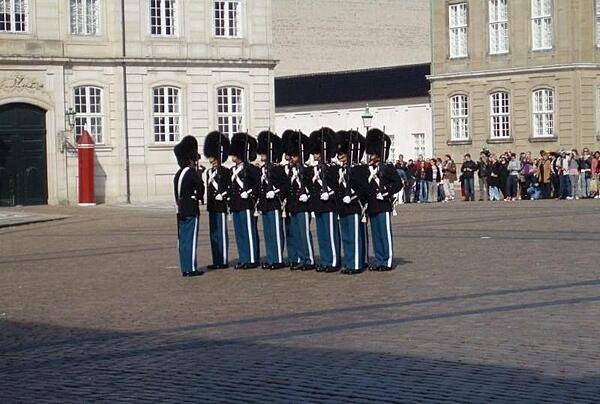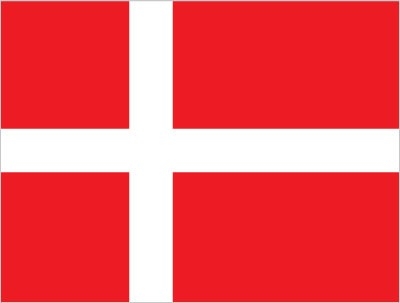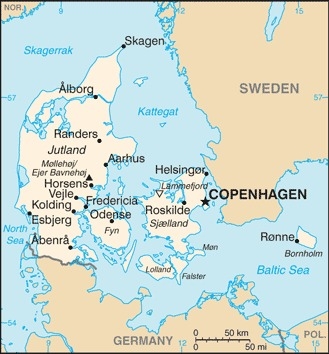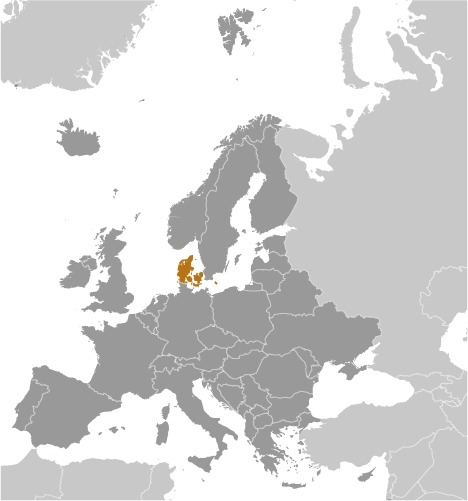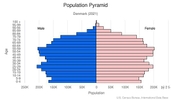Denmark
Introduction
Background
Once the seat of Viking raiders and later a major north European power, Denmark has evolved into a modern, prosperous nation that is participating in the general political and economic integration of Europe. It joined NATO in 1949 and the EEC (now the EU) in 1973. However, the country has opted out of certain elements of the EU's Maastricht Treaty, including the European Economic and Monetary Union, European defense cooperation, and issues concerning certain justice and home affairs.
Visit the Definitions and Notes page to view a description of each topic.
Geography
Location
Northern Europe, bordering the Baltic Sea and the North Sea, on a peninsula north of Germany (Jutland); also includes several major islands (Sjaelland, Fyn, and Bornholm)
Geographic coordinates
56 00 N, 10 00 E
Map references
Europe
Area
total: 43,094 sq km
land: 42,434 sq km
water: 660 sq km
note: includes the island of Bornholm in the Baltic Sea and the rest of metropolitan Denmark (the Jutland Peninsula, and the major islands of Sjaelland and Fyn), but excludes the Faroe Islands and Greenland
Area - comparative
slightly less than twice the size of Massachusetts; about two-thirds the size of West Virginia
Land boundaries
total: 140 km
border countries (1): Germany 140 km
Coastline
7,314 km
Maritime claims
territorial sea: 12 nm
contiguous zone: 24 nm
exclusive economic zone: 200 nm
continental shelf: 200-m depth or to the depth of exploitation
Climate
temperate; humid and overcast; mild, windy winters and cool summers
Terrain
low and flat to gently rolling plains
Elevation
highest point: Mollehoj/Ejer Bavnehoj 171 m
lowest point: Lammefjord -7 m
mean elevation: 34 m
Natural resources
petroleum, natural gas, fish, arable land, salt, limestone, chalk, stone, gravel and sand
Land use
agricultural land: 63.4% (2018 est.)
arable land: 58.9% (2018 est.)
permanent crops: 0.1% (2018 est.)
permanent pasture: 4.4% (2018 est.)
forest: 12.9% (2018 est.)
other: 23.7% (2018 est.)
note: highest percentage of arable land for any country in the world
Irrigated land
4,350 sq km (2012)
Population distribution
with excellent access to the North Sea, Skagerrak, Kattegat, and the Baltic Sea, population centers tend to be along coastal areas, particularly in Copenhagen and the eastern side of the country's mainland
Natural hazards
flooding is a threat in some areas of the country (e.g., parts of Jutland, along the southern coast of the island of Lolland) that are protected from the sea by a system of dikes
Geography - note
composed of the Jutland Peninsula and a group of more than 400 islands (Danish Archipelago); controls Danish Straits (Skagerrak and Kattegat) linking Baltic and North Seas; about one-quarter of the population lives in greater Copenhagen
People and Society
Nationality
noun: Dane(s)
adjective: Danish
Ethnic groups
Danish (includes Greenlandic (who are predominantly Inuit) and Faroese) 86.3%, Turkish 1.1%, other 12.6% (largest groups are Polish, Syrian, German, Iraqi, and Romanian) (2018 est.)
note: data represent population by ancestry
Languages
Danish, Faroese, Greenlandic (an Inuit dialect), German (small minority); note - English is the predominant second language
major-language sample(s):
Verdens Faktabog, den uundværlig kilde til grundlæggende oplysninger. (Danish)
The World Factbook, the indispensable source for basic information.
Religions
Evangelical Lutheran (official) 74.7%, Muslim 5.5%, other/none/unspecified (denominations of less than 1% each in descending order of size include Roman Catholic, Jehovah's Witness, Serbian Orthodox Christian, Jewish, Baptist, Buddhist, Church of Jesus Christ, Pentecostal, and nondenominational Christian) 19.8% (2019 est.)
Age structure
0-14 years: 16.42% (male 494,806/female 469,005)
15-24 years: 12.33% (male 370,557/female 352,977)
25-54 years: 38.71% (male 1,149,991/female 1,122,016)
55-64 years: 12.63% (male 370,338/female 371,149)
65 years and over: 19.91% (male 538,096/female 630,475) (2020 est.)
Dependency ratios
total dependency ratio: 57.3
youth dependency ratio: 25.6
elderly dependency ratio: 31.7
potential support ratio: 3.2 (2020 est.)
Median age
total: 42 years
male: 40.9 years
female: 43.1 years (2020 est.)
Population distribution
with excellent access to the North Sea, Skagerrak, Kattegat, and the Baltic Sea, population centers tend to be along coastal areas, particularly in Copenhagen and the eastern side of the country's mainland
Urbanization
urban population: 88.2% of total population (2021)
rate of urbanization: 0.54% annual rate of change (2020-25 est.)
Major urban areas - population
1.359 million COPENHAGEN (capital) (2021)
Sex ratio
at birth: 1.07 male(s)/female
0-14 years: 1.06 male(s)/female
15-24 years: 1.05 male(s)/female
25-54 years: 1.02 male(s)/female
55-64 years: 1 male(s)/female
65 years and over: 0.85 male(s)/female
total population: 0.99 male(s)/female (2020 est.)
Mother's mean age at first birth
29.7 years (2019 est.)
Maternal mortality ratio
4 deaths/100,000 live births (2017 est.)
country comparison to the world: 172Infant mortality rate
total: 3.09 deaths/1,000 live births
male: 3.54 deaths/1,000 live births
female: 2.6 deaths/1,000 live births (2021 est.)
Life expectancy at birth
total population: 81.45 years
male: 79.52 years
female: 83.51 years (2021 est.)
Drinking water source
improved: urban: 100% of population
rural: 100% of population
total: 100% of population
unimproved: urban: 0% of population
rural: 0% of population
total: 0% of population (2017 est.)
Current Health Expenditure
10.1% (2018)
Physicians density
4.01 physicians/1,000 population (2016)
Hospital bed density
2.6 beds/1,000 population (2019)
Sanitation facility access
improved: urban: 100% of population
rural: 100% of population
total: 100% of population
unimproved: urban: 0% of population
rural: 0% of population
total: 0% of population (2017 est.)
HIV/AIDS - people living with HIV/AIDS
6,700 (2020 est.)
note: estimate does not include children
HIV/AIDS - deaths
<100 (2020 est.)
note: estimate does not include children
School life expectancy (primary to tertiary education)
total: 19 years
male: 18 years
female: 19 years (2019)
Unemployment, youth ages 15-24
total: 11.6%
male: 12.6%
female: 10.6% (2020 est.)
Environment
Environment - current issues
air pollution, principally from vehicle and power plant emissions; nitrogen and phosphorus pollution of the North Sea; drinking and surface water becoming polluted from animal wastes and pesticides; much of country's household and industrial waste is recycled
Environment - international agreements
party to: Air Pollution, Air Pollution-Heavy Metals, Air Pollution-Multi-effect Protocol, Air Pollution-Nitrogen Oxides, Air Pollution-Persistent Organic Pollutants, Air Pollution-Sulphur 85, Air Pollution-Sulphur 94, Air Pollution-Volatile Organic Compounds, Antarctic Treaty, Biodiversity, Climate Change, Climate Change-Kyoto Protocol, Climate Change-Paris Agreement, Comprehensive Nuclear Test Ban, Desertification, Endangered Species, Environmental Modification, Hazardous Wastes, Law of the Sea, Marine Dumping-London Convention, Marine Dumping-London Protocol, Marine Life Conservation, Nuclear Test Ban, Ozone Layer Protection, Ship Pollution, Tropical Timber 2006, Wetlands, Whaling
signed, but not ratified: Antarctic-Environmental Protection
Air pollutants
particulate matter emissions: 10.12 micrograms per cubic meter (2016 est.)
carbon dioxide emissions: 31.79 megatons (2016 est.)
methane emissions: 6.54 megatons (2020 est.)
Climate
temperate; humid and overcast; mild, windy winters and cool summers
Land use
agricultural land: 63.4% (2018 est.)
arable land: 58.9% (2018 est.)
permanent crops: 0.1% (2018 est.)
permanent pasture: 4.4% (2018 est.)
forest: 12.9% (2018 est.)
other: 23.7% (2018 est.)
note: highest percentage of arable land for any country in the world
Urbanization
urban population: 88.2% of total population (2021)
rate of urbanization: 0.54% annual rate of change (2020-25 est.)
Revenue from forest resources
forest revenues: 0.02% of GDP (2018 est.)
country comparison to the world: 140Waste and recycling
municipal solid waste generated annually: 4.485 million tons (2015 est.)
municipal solid waste recycled annually: 1,223,060 tons (2015 est.)
percent of municipal solid waste recycled: 27.3% (2015 est.)
Total water withdrawal
municipal: 381.5 million cubic meters (2017 est.)
industrial: 32.9 million cubic meters (2017 est.)
agricultural: 326.7 million cubic meters (2017 est.)
Total renewable water resources
6 billion cubic meters (2017 est.)
Government
Country name
conventional long form: Kingdom of Denmark
conventional short form: Denmark
local long form: Kongeriget Danmark
local short form: Danmark
etymology: the name derives from the words "Dane(s)" and "mark"; the latter referring to a march (borderland) or forest
Government type
parliamentary constitutional monarchy
Capital
name: Copenhagen
geographic coordinates: 55 40 N, 12 35 E
time difference: UTC+1 (6 hours ahead of Washington, DC, during Standard Time)
daylight saving time: +1hr, begins last Sunday in March; ends last Sunday in October; note - applies to continental Denmark only, not to its North Atlantic components
etymology: name derives from the city's Danish appellation Kobenhavn, meaning "Merchant's Harbor"
Administrative divisions
metropolitan Denmark - 5 regions (regioner, singular - region); Hovedstaden (Capital), Midtjylland (Central Jutland), Nordjylland (North Jutland), Sjaelland (Zealand), Syddanmark (Southern Denmark)
Independence
ca. 965 (unified and Christianized under HARALD I Gormsson); 5 June 1849 (became a parliamentary constitutional monarchy)
National holiday
Constitution Day, 5 June (1849); note - closest equivalent to a national holiday
Constitution
history: several previous; latest adopted 5 June 1953
amendments: proposed by the Folketing with consent of the government; passage requires approval by the next Folketing following a general election, approval by simple majority vote of at least 40% of voters in a referendum, and assent of the chief of state; changed several times, last in 2009 (Danish Act of Succession)
Legal system
civil law; judicial review of legislative acts
International law organization participation
accepts compulsory ICJ jurisdiction with reservations; accepts ICCt jurisdiction
Citizenship
citizenship by birth: no
citizenship by descent only: at least one parent must be a citizen of Denmark
dual citizenship recognized: yes
residency requirement for naturalization: 7 years
Suffrage
18 years of age; universal
Executive branch
chief of state: Queen MARGRETHE II (since 14 January 1972); Heir Apparent Crown Prince FREDERIK (elder son of the monarch, born on 26 May 1968)
head of government: Prime Minister Mette FREDERIKSEN (since 27 June 2019)
cabinet: Council of State appointed by the monarch
elections/appointments: the monarchy is hereditary; following legislative elections, the leader of the majority party or majority coalition usually appointed prime minister by the monarch
Legislative branch
description: unicameral People's Assembly or Folketing (179 seats, including 2 each representing Greenland and the Faroe Islands; members directly elected in multi-seat constituencies by party-list proportional representation vote; members serve 4-year terms unless the Folketing is dissolved earlier)
elections: last held on 5 June 2019 (next to be held in June 2023)
election results: percent of vote by party - SDP 25.9%, V 23.4%, DF 8.7%, SLP 8.6%, SF 7.7%, EL 6.9%, C 6.6%, AP 3.0%, NB 2.4%, LA 2.3%; seats by party - SDP 48, V 43, DF 16, SLP 16, SF 14, EL 13, C 12, AP 5, NB 4, LA 4; composition (as of September 2021) - men 108, women 71 (includes 2 from Greenland), percent of women 39.7%
Judicial branch
highest courts: Supreme Court (consists of the court president and 18 judges)
judge selection and term of office: judges appointed by the monarch upon the recommendation of the Minister of Justice, with the advice of the Judicial Appointments Council, a 6-member independent body of judges and lawyers; judges appointed for life with retirement at age 70
subordinate courts: Special Court of Indictment and Revision; 2 High Courts; Maritime and Commercial Court; county courts
Political parties and leaders
The Alternative AP (Franciska ROSENKILDE)
Conservative People's Party or DKF or C [Soren PAPE POULSEN]
Danish People's Party or DF or O [Kristian THULESEN DAHL]
Liberal Alliance or LA or I [Alex VANOPSLAGH]
Liberal Party (Venstre) or V [Jakob ELLEMANN-JENSEN]
New Right Party or NB or D [Pernille VERMUND]
Red-Green Alliance (Unity List) or EL [collective leadership, Mai VILLADSEN, spokesperson]
Social Democrats or SDP or A [Mette FREDERIKSEN]
Social Liberal Party or SLP or B [Sofie CARSTEN NIELSEN]
Socialist People's Party or SF or F [Pia OLSEN DYHR]
International organization participation
ADB (nonregional member), AfDB (nonregional member), Arctic Council, Australia Group, BIS, CBSS, CD, CE, CERN, EAPC, EBRD, ECB, EIB, EITI (implementing country), ESA, EU, FAO, FATF, G-9, IADB, IAEA, IBRD, ICAO, ICC (national committees), ICCt, ICRM, IDA, IEA, IFAD, IFC, IFRCS, IGAD (partners), IHO, ILO, IMF, IMO, IMSO, Interpol, IOC, IOM, IPU, ISO, ITSO, ITU, ITUC (NGOs), MIGA, MINUSMA, NATO, NC, NEA, NIB, NSG, OAS (observer), OECD, OPCW, OSCE, Paris Club, PCA, Schengen Convention, UN, UNCTAD, UNESCO, UNHCR, UNIDO, UNMIL, UNMISS, UNRWA, UNTSO, UPU, WCO, WHO, WIPO, WMO, WTO, ZC
Diplomatic representation in the US
chief of mission: Ambassador Lone Dencker WISBORG (since 8 April 2019)
chancery: 3200 Whitehaven Street NW, Washington, DC 20008
telephone: [1] (202) 234-4300
FAX: [1] (202) 328-1470
email address and website:
wasamb@um.dk
https://usa.um.dk/en
consulate(s) general: Chicago, Houston, New York, Silicon Valley (CA)
Diplomatic representation from the US
chief of mission: Ambassador (vacant); Charge d'Affaires Stuart A. DWYER (since 20 January 2021)
embassy: Dag Hammarskjolds Alle 24, 2100 Kobenhavn 0
mailing address: 5280 Copenhagen Place, Washington DC 20521-5280
telephone: [45] 33-41-71-00
FAX: [45] 35-43-02-23
email address and website:
CopenhagenACS@state.gov
https://dk.usembassy.gov/
Flag description
red with a white cross that extends to the edges of the flag; the vertical part of the cross is shifted to the hoist side; the banner is referred to as the Dannebrog (Danish flag) and is one of the oldest national flags in the world; traditions as to the origin of the flag design vary, but the best known is a legend that the banner fell from the sky during an early-13th century battle; caught up by the Danish king before it ever touched the earth, this heavenly talisman inspired the royal army to victory; in actuality, the flag may derive from a crusade banner or ensign
note: the shifted cross design element was subsequently adopted by the other Nordic countries of Finland, Iceland, Norway, and Sweden, as well as by the Faroe Islands
National symbol(s)
lion, mute swan; national colors: red, white
National anthem
name: "Der er et yndigt land" (There is a Lovely Country); "Kong Christian" (King Christian)
lyrics/music: Adam Gottlob OEHLENSCHLAGER/Hans Ernst KROYER; Johannes EWALD/unknown
note: Denmark has two national anthems with equal status; "Der er et yndigt land," adopted 1844, is a national anthem, while "Kong Christian," adopted 1780, serves as both a national and royal anthem; "Kong Christian" is also known as "Kong Christian stod ved hojen mast" (King Christian Stood by the Lofty Mast) and "Kongesangen" (The King's Anthem); within Denmark, the royal anthem is played only when royalty is present and is usually followed by the national anthem; when royalty is not present, only the national anthem is performed; outside Denmark, the royal anthem is played, unless the national anthem is requested
Economy
Economic overview
This thoroughly modern market economy features advanced industry with world-leading firms in pharmaceuticals, maritime shipping, and renewable energy, and a high-tech agricultural sector. Danes enjoy a high standard of living, and the Danish economy is characterized by extensive government welfare measures and an equitable distribution of income. An aging population will be a long-term issue.
Denmark’s small open economy is highly dependent on foreign trade, and the government strongly supports trade liberalization. Denmark is a net exporter of food, oil, and gas and enjoys a comfortable balance of payments surplus, but depends on imports of raw materials for the manufacturing sector.
Denmark is a member of the EU but not the eurozone. Despite previously meeting the criteria to join the European Economic and Monetary Union, Denmark has negotiated an opt-out with the EU and is not required to adopt the euro.
Denmark is experiencing a modest economic expansion. The economy grew by 2.0% in 2016 and 2.1% in 2017. The expansion is expected to decline slightly in 2018. Unemployment stood at 5.5% in 2017, based on the national labor survey. The labor market was tight in 2017, with corporations experiencing some difficulty finding appropriately-skilled workers to fill billets. The Danish Government offers extensive programs to train unemployed persons to work in sectors that need qualified workers.
Denmark maintained a healthy budget surplus for many years up to 2008, but the global financial crisis swung the budget balance into deficit. Since 2014 the balance has shifted between surplus and deficit. In 2017 there was a surplus of 1.0%. The government projects a lower deficit in 2018 and 2019 of 0.7%, and public debt (EMU debt) as a share of GDP is expected to decline to 35.6% in 2018 and 34.8% in 2019. The Danish Government plans to address increasing municipal, public housing and integration spending in 2018.
Real GDP (purchasing power parity)
$326.2 billion note: data are in 2017 dollars (2020 est.)
$335.36 billion note: data are in 2017 dollars (2019 est.)
$326.07 billion note: data are in 2017 dollars (2018 est.)
note: data are in 2010 dollars
Real GDP growth rate
2.85% (2019 est.)
2.18% (2018 est.)
2.83% (2017 est.)
Real GDP per capita
$55,900 note: data are in 2017 dollars (2020 est.)
$57,700 note: data are in 2017 dollars (2019 est.)
$56,300 note: data are in 2017 dollars (2018 est.)
note: data are in 2010 dollars
GDP (official exchange rate)
$350.037 billion (2019 est.)
Inflation rate (consumer prices)
0.7% (2019 est.)
0.8% (2018 est.)
1.1% (2017 est.)
Credit ratings
Fitch rating: AAA (2003)
Moody's rating: Aaa (1999)
Standard & Poors rating: AAA (2001)
GDP - composition, by sector of origin
agriculture: 1.3% (2017 est.)
industry: 22.9% (2017 est.)
services: 75.8% (2017 est.)
GDP - composition, by end use
household consumption: 48% (2017 est.)
government consumption: 25.2% (2017 est.)
investment in fixed capital: 20% (2017 est.)
investment in inventories: -0.2% (2017 est.)
exports of goods and services: 54.5% (2017 est.)
imports of goods and services: -47.5% (2017 est.)
Agricultural products
milk, wheat, barley, potatoes, sugar beet, pork, rye, rapeseed, oats, poultry
Industries
wind turbines, pharmaceuticals, medical equipment, shipbuilding and refurbishment, iron, steel, nonferrous metals, chemicals, food processing, machinery and transportation equipment, textiles and clothing, electronics, construction, furniture and other wood products
Labor force - by occupation
agriculture: 2.4%
industry: 18.3%
services: 79.3% (2016 est.)
Population below poverty line
12.5% (2018 est.)
Gini Index coefficient - distribution of family income
28.7 (2017 est.)
27.5 (2010 est.)
Household income or consumption by percentage share
lowest 10%: 9%
highest 10%: 23.4% (2016 est.)
Budget
revenues: 172.5 billion (2017 est.)
expenditures: 168.9 billion (2017 est.)
Public debt
35.3% of GDP (2017 est.)
37.9% of GDP (2016 est.)
note: data cover general government debt and include debt instruments issued (or owned) by government entities other than the treasury; the data include treasury debt held by foreign entities; the data include debt issued by subnational entities, as well as intra-governmental debt; intragovernmental debt consists of treasury borrowings from surpluses in the social funds, such as for retirement, medical care, and unemployment; debt instruments for the social funds are not sold at public auctions
Fiscal year
calendar year
Current account balance
$30.935 billion (2019 est.)
$24.821 billion (2018 est.)
Exports
$191.53 billion note: data are in current year dollars (2020 est.)
$204.14 billion note: data are in current year dollars (2019 est.)
$200.81 billion note: data are in current year dollars (2018 est.)
Exports - partners
Germany 14%, United States 11%, Sweden 10%, United Kingdom 7%, Norway 6%, Netherlands 5%, China 5% (2019)
Exports - commodities
packaged medicines, electric generators, pork, refined petroleum, medical cultures/vaccines (2019)
Imports
$170.33 billion note: data are in current year dollars (2020 est.)
$178.44 billion note: data are in current year dollars (2019 est.)
$179.95 billion note: data are in current year dollars (2018 est.)
Imports - partners
Germany 21%, Sweden 11%, Netherlands 8%, China 7% (2019)
Imports - commodities
cars, refined petroleum, packaged medicines, crude petroleum, broadcasting equipment (2019)
Reserves of foreign exchange and gold
$75.25 billion (31 December 2017 est.)
$64.25 billion (31 December 2016 est.)
Debt - external
$504.808 billion (2019 est.)
$517.972 billion (2018 est.)
Exchange rates
Danish kroner (DKK) per US dollar -
6.16045 (2020 est.)
6.7506 (2019 est.)
6.5533 (2018 est.)
6.7236 (2014 est.)
5.6125 (2013 est.)
Unemployment, youth ages 15-24
total: 11.6%
male: 12.6%
female: 10.6% (2020 est.)
Energy
Electricity access
electrification - total population: 100% (2020)
Electricity - installed generating capacity
14.34 million kW (2016 est.)
country comparison to the world: 52Electricity - from fossil fuels
46% of total installed capacity (2016 est.)
country comparison to the world: 158Electricity - from nuclear fuels
0% of total installed capacity (2017 est.)
country comparison to the world: 77Electricity - from hydroelectric plants
0% of total installed capacity (2017 est.)
country comparison to the world: 167Electricity - from other renewable sources
54% of total installed capacity (2017 est.)
country comparison to the world: 2Refined petroleum products - production
183,900 bbl/day (2017 est.)
country comparison to the world: 55Refined petroleum products - consumption
158,500 bbl/day (2017 est.)
country comparison to the world: 64Natural gas - proved reserves
12.86 billion cu m (1 January 2018 est.)
country comparison to the world: 77Communications
Telephones - fixed lines
total subscriptions: 937,469 (2020)
subscriptions per 100 inhabitants: 16.19 (2020 est.)
Telephones - mobile cellular
total subscriptions: 7,144,123 (2020)
subscriptions per 100 inhabitants: 123.3 (2020 est.)
Telecommunication systems
general assessment: Denmark has one of the highest broadband penetration rates globally, with near universal availability of superfast connections; progressive regulator encouraged upgrades to cable and DSL infrastructure; fast growing fiber networks with aim for nation-wide build-out; comprehensive LTE with 90% coverage of 5G; operator expands NB-IoT across its LTE network; survey underway for cable connecting Denmark to Norway; upgrades to submarine cable connection to North America; importer of broadcasting equipment from EU neighbors (2020)
domestic: fixed-line 17 per 100, 126 per 100 for mobile-cellular (2019)
international: country code - 45; landing points for the NSC, COBRAcable, CANTAT-3, DANICE, Havfrue/AEC-2, TAT-14m Denmark-Norway-5 & 6, Skagenfiber West & East, GC1, GC2, GC3, GC-KPN, Kattegat 1 & 2 & 3, Energinet Lyngsa-Laeso, Energinet Laeso-Varberg, Fehmarn Balt, Baltica, German-Denmark 2 & 3, Ronne-Rodvig, Denmark-Sweden 15 & 16 & 17 & 18, IP-Only Denmark-Sweden, Scandinavian South, Scandinavian Ring North, Danica North, 34 series of fiber-optic submarine cables link Denmark with Canada, Faroe Islands, Germany, Iceland, Netherlands, Norway, Poland, Russia, Sweden, US and UK; satellite earth stations - 18 (6 Intelsat, 10 Eutelsat, 1 Orion, 1 Inmarsat (Blaavand-Atlantic-East)); note - the Nordic countries (Denmark, Finland, Iceland, Norway, and Sweden) share the Danish earth station and the Eik, Norway, station for worldwide Inmarsat access (2019)
note: the COVID-19 pandemic continues to have a significant impact on production and supply chains globally; since 2020, some aspects of the telecom sector have experienced downturn, particularly in mobile device production; many network operators delayed upgrades to infrastructure; progress towards 5G implementation was postponed or slowed in some countries; consumer spending on telecom services and devices was affected by large-scale job losses and the consequent restriction on disposable incomes; the crucial nature of telecom services as a tool for work and school from home became evident, and received some support from governments
Broadcast media
strong public-sector TV presence with state-owned Danmarks Radio (DR) operating 6 channels and publicly owned TV2 operating roughly a half-dozen channels; broadcasts of privately owned stations are available via satellite and cable feed; DR operates 4 nationwide FM radio stations, 10 digital audio broadcasting stations, and 14 web-based radio stations; 140 commercial and 187 community (non-commercial) radio stations (2019)
Internet users
total: 5.69 million (2021 est.)
percent of population: 96.55% (2020 est.)
Broadband - fixed subscriptions
total: 2,571,736 (2020)
subscriptions per 100 inhabitants: 44.4 (2020 est.)
Transportation
National air transport system
number of registered air carriers: 10 (2020)
inventory of registered aircraft operated by air carriers: 76
annual passenger traffic on registered air carriers: 582,011 (2015)
annual freight traffic on registered air carriers: 0 mt-km (2015)
Airports - with paved runways
total: 28
over 3,047 m: 2
2,438 to 3,047 m: 7
1,524 to 2,437 m: 5
914 to 1,523 m: 12
under 914 m: 2 (2017)
Airports - with unpaved runways
total: 52
914 to 1,523 m: 5
under 914 m: 47 (2013)
Pipelines
1536 km gas, 330 km oil (2015)
Railways
total: 3,476 km (2017)
standard gauge: 3,476 km 1.435-m gauge (1,756 km electrified) (2017)
Roadways
total: 74,558 km (2017)
paved: 74,558 km (includes 1,205 km of expressways) (2017)
Merchant marine
total: 717
by type: bulk carrier 8, container ship 148, general cargo 68, oil tanker 105, other 388 (2021)
Ports and terminals
major seaport(s): Baltic Sea - Aarhus, Copenhagen, Fredericia, Kalundborg
cruise port(s): Copenhagen
river port(s): Aalborg (Langerak)
dry bulk cargo port(s): Ensted (coal)
North Sea - Esbjerg,
Military and Security
Military and security forces
Danish Armed Forces (Forsvaret): Royal Danish Army, Royal Danish Navy, Royal Danish Air Force, Danish Home Guard (Reserves) (2021)
note - the Danish military maintains a Joint Arctic Command with the mission of protecting the sovereignty of the Kingdom of Denmark in the Arctic Region, including the Faroe Islands and Greenland; it also conducts maritime pollution prevention, environmental monitoring, fishery inspections, search and rescue, hydrographical surveys, and provides support to governmental science missions
Military expenditures
1.4% of GDP (2020)
1.3% of GDP (2019)
1.28% of GDP (2018)
1.14% of GDP (2017)
1.15% of GDP (2016)
Military and security service personnel strengths
the Danish military has approximately 16,000 active duty personnel (8,000 Army; 3,000 Navy; 3,000 Air Force; 2,000 other) (2021)
Military equipment inventories and acquisitions
the Danish military inventory is comprised of a mix of modern European, US, and domestically-produced equipment; the US is the largest supplier of military equipment to Denmark since 2010; the Danish defense industry is active in the production of naval vessels, defense electronics, and subcomponents of larger weapons systems, such as the US F-35 fighter aircraft (2021)
Military deployments
140 Middle East/Iraq (NATO) (2021)
Military service age and obligation
18 years of age for compulsory and voluntary military service; conscripts serve an initial training period that varies from 4 to 12 months depending on specialization; former conscripts are assigned to mobilization units; women eligible to volunteer for military service; in addition to full time employment, the Danish Military offers reserve contracts in all three branches (2021)
Military - note
Denmark is a member of NATO and was one of the original 12 countries to sign the North Atlantic Treaty (also known as the Washington Treaty) in 1949
Denmark is a member of the EU, but opted out of the EU’s Common Defense and Security Policy, and therefore does not participate in EU military operations or in the cooperation on development and acquisition of military capabilities within the EU framework
the Danish Armed Forces cooperate closely with the militaries of other Nordic countries through the Nordic Defense Cooperation (NORDEFCO), which consists of Denmark, Finland, Iceland, Norway, and Sweden; areas of cooperation include armaments, education, human resources, training and exercises, and operations; NORDEFCO was established in 2009
Terrorism
Terrorist group(s)
Islamic State of Iraq and ash-Sham (ISIS); Islamic Revolutionary Guard Corps/Qods Force
note: details about the history, aims, leadership, organization, areas of operation, tactics, targets, weapons, size, and sources of support of the group(s) appear(s) in Appendix-T
Transnational Issues
Disputes - international
Iceland, the UK, and Ireland dispute Denmark's claim that the Faroe Islands' continental shelf extends beyond 200 nm; sovereignty dispute with Canada over Hans Island in the Kennedy Channel between Ellesmere Island and Greenland; Denmark (Greenland) and Norway have made submissions to the Commission on the Limits of the Continental Shelf (CLCS) and Russia is collecting additional data to augment its 2001 CLCS submission
Refugees and internally displaced persons
refugees (country of origin): 19,878 (Syria), 5,399 (Eritrea) (2020)
stateless persons: 11,655 (2020)
